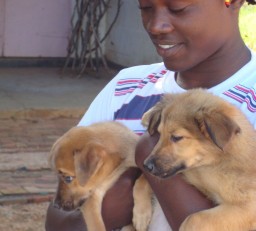Dogs and cats: a welfare and conservation concern
24/06/2014
Dogs and cats: a welfare and conservation concerned

As the habitat available to populations of endangered wildlife is increasingly degraded and reduced by the activities of man, contact between domestic livestock (including domestic dogs and cats) and wild animals has increased.This inevitably leads to a greater risk of disease spreading from domestic dogs and cats to wild carnivores and other species. Uncontrolled breeding of dogs and cats only makes matters worse. With dog and cat numbers globally on the increase we are facing an increasing welfare and conservation crisis.

Canine Distemper Virus (CDV) has been confirmed in Amur tigers in the Russian Far East (left) and Bengal tigers in India and it is known that the domestic dogs are passing it on to the big cats. CDV is dangerous as it seems to be changing the behaviour of tigers to make them tolerant of people. This means they will come into conflict situations more frequently and easier for poachers to catch.WVI is supporting an Indonesian initiative to survey the dogs and wildlife in Sumatra to see whether it is affecting the endangered Sumatran tiger. We have a similar initiative in Bangladesh and are looking to work in other tiger countries.WVI provides the veterinary expertise for mobile vaccination and minor injuries clinic on the egde of Hwange National Park, Zimbabwe. MSD Animal Health help with both distemper and rabies vaccines which create a controlled disease barrier between domestic dogs and African painted dogs in the park. We hope to avoid the devastation that was caused by CDV in the Serengeti in the 1990s and have used lessons learnt by the Serengeti Vaccination Project to customise our activities.Rabies is a serious threat to human and animal populations where WVI works in Bangladesh. It has one of the highest rabies rates in the world. In due course, WVI hopes to work with WildTeam and other partners to vaccinate dogs in these villages against diseases such as CDV and rabies. Not only will this increase the welfare of the individual dog and protect the wildlife, but will have an instant positive effect on the rabies toll in humans.While vaccination of owned and feral dogs and cats can have a significant impact, the uncontrolled breeding of dogs in these cases makes the job all the harder.

Neutering domestic cats and dogs in the field is a slow, difficult process given the time, equipment and training needed to perform in an appropriate way.
WVI’s patron Steve Leonard does an amazing job castrating dogs during the mobile vaccination and minor injuries clinics for domestic dogs that we take part in out the outside of Hwange National Park.
We recently met Luke Gamble and his team at BSAVA 2014 where the WVI stand was next to the WVS (Worldwide Veterinary Service) and discussed the issue of neutering and the difficulties involved, particularly with strays, lack of skilled vets and lack of equipment.
Mission Rabies are doing an excelent job catching and vaccinating 10,000s of dogs in a day, at least 50% are stray and good at avoiding nets. These dogs are not currently neutered which means they are able to produce many puppies for the Mission Rabies teams to vaccinate on their next rounds.
In order to address this, their big yellow truck is doing a great job at churning out vets who are experienced at neutering dogs but it is still but a few in comparison to the size of the job.
Imagine if they had injectable neutering!
Donate to help
What kind of dog can kill a cat like this?

A sick dog, passing on deadly distemper.
Infected tigers can die.
They can also lose their fear of man.
A tiger with no fear can become a killer.
Then, tragically, the tiger may well be killed.
WVI is determined to break the deadly cycle. Our big cat vet Dr John Lewis is working in freezing Russia and in the forests of Sumatra and Bangladesh on vital research.
Can you help and save the tiger?
Fundraise to win …..
pledge to raise funds for WVI and win a trip with a zoo vet. Contact the office for more information: info@wildlifevetsinternational.org
Did you know?
Even in the UK, domestic cat numbers are on the increase (over 13 million) with the worrying statistic that as many as 40% are not neutered by the age of 1 year old, way past sexual maturity.
Domestic cats are perfectly capable of becoming totally feral living entirely off wildlife prey and are in part responsible for the decline of native song birds. Feral and stray dogs are filling rescue centres to bursting.
.png)
.png)

.png)
.png)







.png)






.png)
.png)




.png)


